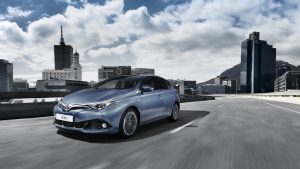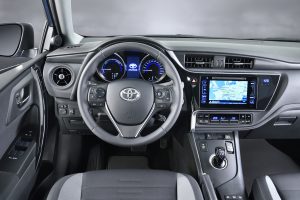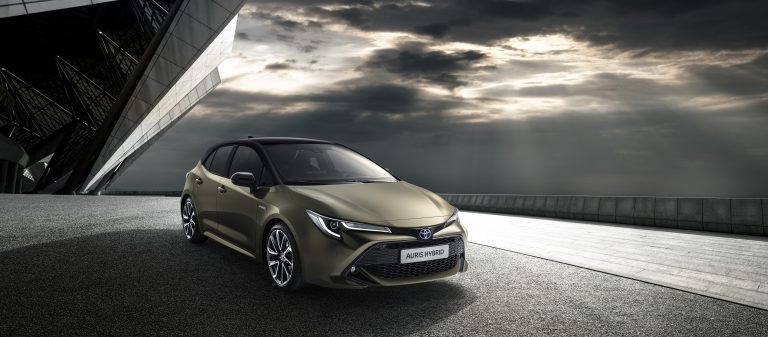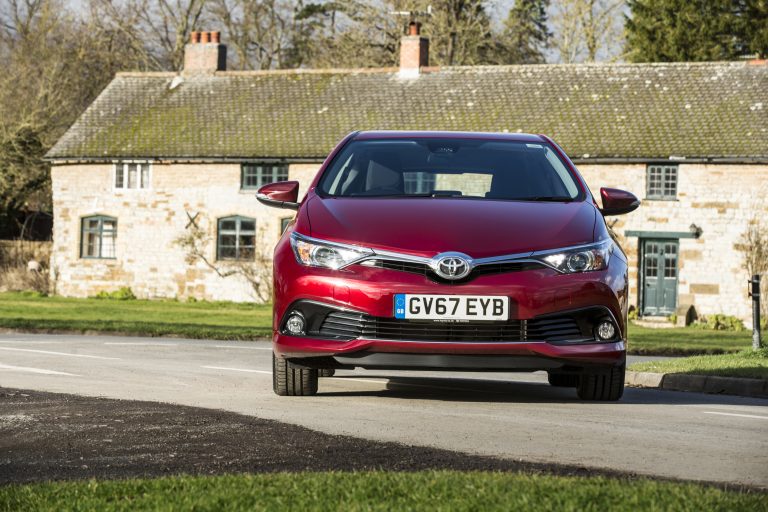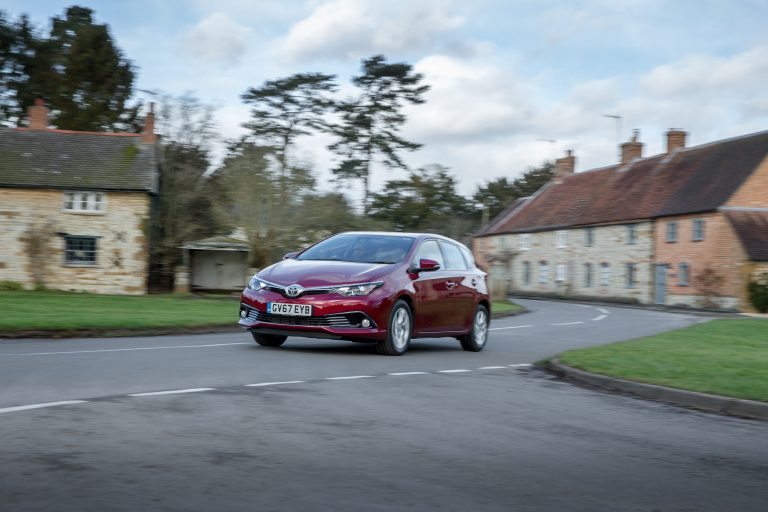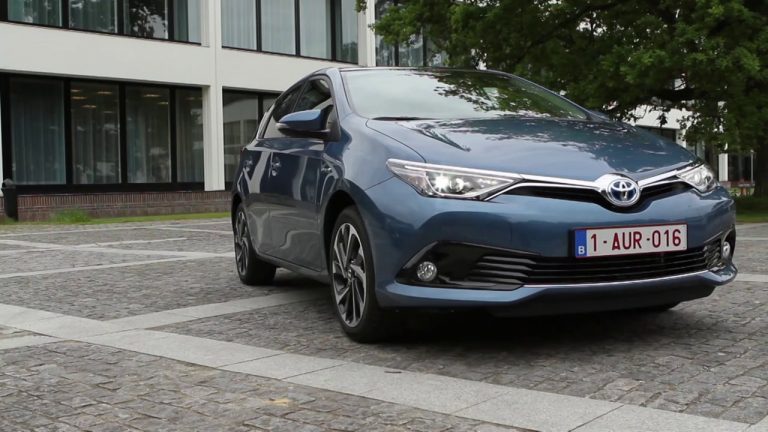The New Toyota Auris
- View full image gallery of the new Toyota Auris here
Toyota has increased the appeal of the Auris range of hatchbacks and wagons to reach a wider range of customers, offering new or revised diesel, petrol and hybrid powertrains, updated equipment specifications and new safety equipment.
In 2010 Toyota launched the original Auris Hybrid, becoming the first and only manufacturer to offer a choice of three powertrains in the compact/family car market. Today, with limited and more expensive competition, the extensive Auris range remains a unique proposition.
All versions of Auris – hatchback, hybrid and the Touring Sports wagon – continue to be built by Toyota Manufacturing UK at its Burnaston plant, near Derby.
Auris Hybrid represents great value for money. CO2 emissions from 79g/km* and combined cycle fuel economy from 80.7mpg* attract significant tax incentives and, coupled with the hybrid system’s established reliability and durability, exceptionally low running costs.
Toyota’s full hybrid technology is now established as a mainstream powertrain choice, with Auris Hybrid’s smooth, relaxed and stress-free driving is proving increasingly popular with compact car customers.
The hybrid model currently accounts for more than 50 per cent of all Auris sales in western Europe, a share that’s expected to increase over the next few years. Since the hybrid joined the range, more than 200,000 have been sold and today Auris attracts more sales than any other hybrid on the market.
The 2015 Auris range reflects the changes in this highly competitive market and feedback from Toyota customers with significant improvements in five key areas: design, sensory quality, the hybrid model, safety and (increasing the model’s segment coverage by about 40 per cent) powertrains.
An all-new 1.2-litre direct injection turbocharged engine joins the existing petrol line-up. There is a new 1.6-litre D-4D and the 1.4-litre D-4D has been substantially upgraded to give best-in-class CO2 emissions in the 90bhp power category. Every engine in the range now meets Euro 6 emissions regulations.
The refreshed exterior styling presents a new-look front and rear, giving Auris a more prestigious and sophisticated road presence. On board, the sensory quality of the cabin has been significantly raised with a redesigned dashboard, premium quality trims and surface finishes and a new 4.2-inch colour TFT multi-information screen (on all hybrids and higher grade models).
The 2015 Auris range further benefits from suspension and steering revisions to improve ride comfort, handling and driver involvement. Numerous measures have also been introduced NVH transmitted into the cabin.
Finally, the grade structure has been revised to bring Auris Hybrid into line with the rest of the range.
Details of UK market specifications will be announced later.
Exterior design
Auris’s front and rear have been comprehensively redesigned to give the vehicle the visual impression of a broader stance and lower centre gravity, and a more prestigious, sophisticated road presence.
At the front, a pair of chrome wings emerges from a new, more prominent Toyota emblem. The powerful upper wings underscore the front lip of the bonnet, running the full width of the car. The lower wings are less prominent and sweep down into the upper surface of the bumper, holding the sharply angled inside edge of the LED headlamp clusters, which include LED daytime running lights.
LED lamps have many advantages over conventional bulbs: the light they produce is closest to daylight (on the Kelvin scale); they use less energy; and they have a service life of up to 100,000 hours – almost the same as the vehicle itself.
The lower grille, set beneath a more prominent front bumper, now runs the full width of the car. It has a narrow centre section, underscored by a chrome accent on the lip spoiler, which widens into deep pods which house integrated fog lights, at the furthest edges of the new design.
In profile the new front and rear styling generate longer overhangs, improving the overall balance of the design and leading the eye in a sweeping line from the front Toyota emblem to the rear lamp cluster. A new shark fin roof antenna and 16 and 17-inch alloy wheel designs add further impact.
To the rear, the lower half of the car has been completely redesigned, again to add visual emphasis to the vehicle’s broad stance. The width of the deeper, more muscular bumper design is amplified by the location of reflector lamp housings at the furthest edges and by a thin chrome trim line.
The rear lamp clusters use LED light guide technology, giving Auris its own, distinctive lighting signature.
New exterior colours will be added to the range available for Auris.
Improved interior sensory quality
The sensory quality of new Auris’s cabin has been raised with a reduction in the visual mass of the dashboard design, cleaner integration of the instrumentation (with more uniform illumination) and a more consistent shape and finish to grained surfaces and trim elements.
The driver’s instrument binnacle has a stronger, more sporting design with tubed tachometer and speedometer dials either side of a new 4.2-inch colour TFT multi-information screen.
The centre stack instrumentation is set within a more curvaceous dashboard. It has been integrated into a single, smooth surface, incorporating touch-sensitive switchgear with more consistent back-lighting. The dashboard’s upper surface and fascia are finished in the same soft-touch material, with a consistent grain pattern.
Many details, such as the air vents, doorhandles and gear lever surround, have been redesigned to give a crisper, high-quality appearance. The shape and finish of chrome trim features have been harmonised and new set upholstery designs complete the more premium quality cabin environment.
Revised powertrain line-up
The Auris petrol, diesel and hybrid powertrain line-up has been extended and extensively revised, reflecting changing trends in the C-segment which call for further reductions in fuel consumption, emissions and cost of ownership, without diminishing performance or driving pleasure.
Every engine in the range now meets Euro 6 emissions regulations.
The 1.2T, an all-new direct injection turbocharged engine joins the established 1.33-litre VVT-i and 1.6-litre Valvematic units to give customers an expanded choice of petrol engines. There is also a new 1.6-litre D-4D diesel unit (which replaces a current 2.0-litre D-4D in some European markets outside the UK) and the 1.4-litre D-4D has been substantially upgraded.
The 1.8-litre hybrid powertrain completes one of the broadest ranges for any model in this part of the market. Toyota’s full hybrid technology, which in Auris delivers a feel-good driving experience plus class-leading emissions from as low as 79g/km*, accounted for more than half of all European Auris sales in 2014, confirming the fact it has become a mainstream proposition.
Every powertrain comes with the benefits of Toyota Optimal Drive, a combination of advanced technologies and internal improvements designed to optimise the balance of performance and driving enjoyment with fuel economy and low emissions.
Lower full hybrid system emissions
Auris Hybrid now returns class-leading, highly tax-efficient CO2 emissions from as low as 79g/km* (combined cycle).
The Hybrid Synergy Drive system’s 1.8-litre VVT-i petrol engine and electric motor generate maximum power of 134bhp, giving the Auris Hybrid hatchback 0 – 62mph acceleration in 10.9 seconds and a top speed of 112mph.
Auris Hybrid generates virtually no NOx and particulate matter emissions. Moreover, when running in the selectable EV electric mode (a function not available in mild hybrids), Auris Hybrid can be driven for up to two kilometres at speeds of up to around 30mph, with zero CO2, NOx and particulate matter tailpipe emissions., according to the level of battery charge and driving conditions.
The powertrain is engineered to eliminate the need for the petrol engine to run as much as possible in city driving. Toyota’s own data show the cumulative effect of full hybrid operation leads to high proportions of zero-emissions driving being achieved.
1.2T: an all-new, direct injection turbo petrol engine
The all-new 1,197cc, 16-valve, four-cylinder, direct injection turbo petrol engine offers performance similar to that of a 1.6 engine, but with remarkably lower fuel consumption and CO2 emissions.
This lightweight, highly compact unit features a number of technologies, including direct injection, enhanced intelligent variable valve timing (Dual VVT-iW), a high tumble port cylinder head with an integrated exhaust manifold, a lightweight valvetrain, a variable control oil jet system and a resin intake manifold and intake pipes.
The turbo, the direct injection (which allows multiple injections) and the new VVT-iW work together to provide high torque at low revs, good performance and low fuel consumption.
Maximum power output is 114bhp and an impressive 185Nm of torque is generated from 1,500 to 4,000rpm. Driving through a six-speed manual transmission, the engine gives the new Auris 1.2T hatchback a competitive 0 – 62mph acceleration time of 10.1 seconds and a 104mph top speed.
At the same time, the new engine returns average fuel consumption of 60.1mpg* and 109g/km* CO2 emissions, attracting significant cost of ownership benefits for customers. Using Toyota’s Multidrive S transmission further improves these benchmark figures, to 61.4mpg* and 106g/km*.
New 1.6-litre D-4D diesel
A new 1,598cc turbo diesel makes its first appearance in the Auris range, replacing a 2.0-litre D-4D that has been available in some European markets.
It develops 110bhp and maximum torque of 270Nm between 1,750 and 2,250rpm. This equips the Auris 1.6 D-4D hatch with class-competitive performance figures of 0 – 62mph in 10.5 seconds and a top speed of 118mph.
Conversely, CO2 emissions are markedly lower than those of the outgoing 2.0 D-4D, falling to 104g/km*. Average fuel consumption is 68.9mpg*. Cost of ownership is further reduced by new, extended servicing intervals.
Uprated 1.4-litre D-4D
The 1,364cc turbodiesel has been upgraded to comply with Euro 6 regulations, but the changes go significantly further than simply meeting the required emissions performance.
Many improvements have been made, both to improve performance and reduce emissions. A new turbocharger reduces friction in the turbine shaft by 20 per cent and improves efficiency to generate a higher boost pressure at low engine speeds.
The engine has a new solenoid fuel injection system with a larger supply pump and higher common rail injection pressure (180mpa). A NOx storage reduction (NSR) catalyst has been adopted within the exhaust system to meet the Euro 6 requirement for a 55 per cent reduction in Nox.
A new piston design with an open chamber combustion bowl improves fuel economy by 3.4 per cent. The new pistons feature a Diamond-like Carbon coating which reduces friction and thus supports lower fuel consumption.
A new plastic cylinder head cover reduces component weight by 40 per cent and offers improvements to both camshaft lubrication and oil capture performance.
The engine develops 89bhp. The breadth of torque generation has been expanded 400rpm lower down the rev range, with a maximum 205Nm now available from 1,400rpm to 2,800rpm. The Auris 1.4 D-4D hatchback will move from rest to 62mph in 12.5 seconds and reach a maximum speed of 112mph.
Comparisons in performance between the previous Euro 5 engine and the revised 1.4 D-4D are shown in the table below.
| 1.4 D-4D Euro 5 | 1.4 D-4D Euro 6 | |
| Displacement (cc) | 1,364 | 1,364 |
| Compression ratio | 16.5:1 | 16.5:1 |
| Common rail pressure (mpa) | 160 | 180 |
| NOx reduction system | High-pressure loop, exhaust gas recirculation | NOx storage and reduction, high-pressure loop, exhaust gas recirculation |
| Max. power (bhp/kW @ rpm) | 89/66 @ 3,800 | 89/66 @ 3,800 |
| Max. torque (Nm @ rpm) | 205 @ 1,800 – 2,800 | 205 @ 1,400 – 2,8000 |
| CO2 emissions (g/km, combined cycle) | 99 | 89* |
Equipped with a manual transmission and stop and start technology, the 1.4 D-4D now returns combined cycle fuel consumption of 83.1mpg and benefits from a substantial reduction in CO2 emissions to 89g/km.
Multidrive S continuously variable transmission
The 1.2T and 1.6 Valvematic versions of the 2015 Auris will be available with Multidrive S, a continuously variable transmission with two modes – fully automatic, seamless shifting or a sequential, stepped seven-speed Sport mode.
In Sport mode, the system is optimised for response and direct engine control; the transmission step position ca be selected using the gear lever or shift paddles mounted on the steering column. Sport mode also features precise cornering control. When it detects deceleration, it downshifts and applies engine braking to assist the braking force. On exiting a corner, predictive downshift logic ensures the optimum gear ration is selected for the required level of acceleration.
Improved driving dynamics and NVH
The new Auris range benefits from further suspension and steering revisions designed to improve ride comfort and handling. Numerous measure have also been introduced to reduce the transmission of noise, vibration and harshness into the cabin.
Components in the MacPherson strut front suspension have been revised, including the design of the coil springs, shock absorbers, upper insulators, bound stoppers and stabiliser bushes.
For its rear suspension, Auris uses either a double wishbone (1.2T, 1,6 Valvematic, 1.6 D-4D and 1.8 Hybrid) or a torsion bar (1.3 VVT-i petrol, 1.4 D-4D) system.
In combination, the changes to the suspension improve initial roll damping, minimise friction and improve straight-line ride comfort.
In addition, the electric power steering system’s mapping has been tuned to further build steering weight as vehicle speed rises, giving better feedback between 35 and 50mph.
Improvements to Auris’s NVH measures ensure the new Toyota’s more comfortable ride is complemented by a noticeably quieter cabin.
Soundproofing has been improved by adding additional sound-absorbing materials in strategic locations around the cowl, instrument panel and transmission tunnel. An outer tunnel silencer has been added to minimise transmission noise.
Additional sealing in the front wing, dashboard and door area further cuts the amount of engine, road and wind noise reaching the cabin.
Safety
Auris has already gained a five-star rating in the Euro NCAP crash test programme, but the 2015 model range takes active safety and driver assistance to new levels with the optional Toyota Safety Sense pack.
This provides a Pre-Collision System, Lane Departure Alter, Automatic High Beam and Road Sign Assist, functions which process information provide by a compact laser and camera unit mounted on the head of the windscreen.
All Toyota Safety Sense status and alert information is displayed on the new multi-information screen in the driver’s instrument binnacle.
* Fuel and emissions figures are provisional, subject to final homologation.
2015 TOYOTA AURIS OUTLINE TECHNICAL SPECIFICATIONS
Performance data refer to hatchback models unless otherwise indicated; fuel and emissions figures remain provisional prior to final homologation.
| 1.33 DUAL VVT-i | ||||
| Type | Four cylinders in-line | |||
| Valve mechanism | DOHC 16-valve with Dual VVT-i | |||
| Displacement (cc) | 1,329 | |||
| Max power (bhp/kW @ rpm) | 98/73 @ 6,000 | |||
| Max torque (Nm @ rpm) | 128 @ 3,800 | |||
| Stop & Start system | Yes | |||
| Max. speed (mph) | 109 | |||
| Acceleration 0 – 62mph (sec) | 12.6 | |||
| Fuel consumption | Urban | 42.8 | ||
| Extra-urban | 60.1 | |||
| Combined | 52.3 | |||
| CO2 emissions (g/km) | 125 | |||
| 1.2T TURBO | ||||
| Type | Four cylinders in-line | |||
| Valve mechanism | DOHC 16-valve with Dual VVT-iW | |||
| Displacement (cc) | 1,197 | |||
| Max power (bhp/kW @ rpm) | 114/85 @ 5,200 – 5,600 | |||
| Max torque (Nm @ rpm) | 185 @ 1,500 – 4,000 | |||
| Stop & Start system | Yes | |||
| Max. speed (mph) | 124 – manual121 – Multidrive S | |||
| Acceleration 0 – 62mph (sec) | 10.1 – manual10.5 – Multidrive S | |||
| Fuel consumption | Urban | 48.751.4 – Multidrive S | ||
| Extra-urban | 68.9 – manual68.9 – Multidrive S | |||
| Combined | 52.3 – manual61.4 – Multidrive S | |||
| CO2 emissions (g/km) | 109 – manual106 – Multidrive S | |||
| 1.6 VALVEMATIC | ||||
| Type | Four cylinders in-line | |||
| Valve mechanism | DOHC 16-valve Valvematic | |||
| Displacement (cc) | 1,598 | |||
| Max power (bhp/kW @ rpm) | 130/97 @ 6,400 | |||
| Max torque (Nm @ rpm) | 160 @ 4,400 | |||
| Stop & Start system | No | |||
| Max. speed (mph) | 118 – manual124 – Multidrive S | |||
| Acceleration 0 – 62mph (sec) | 10.1 – manual11.1 – Multidrive S | |||
| Fuel consumption | Urban | 35.8 – manual38.7 – Multidrive S | ||
| Extra-urban | 58.9 – manual61.4 – Multidrive S | |||
| Combined | 47.9 – manual50.4 – Multidrive S | |||
| CO2 emissions (g/km) | 138 – manual129 – Multidrive S | |||
| 1.4 D-4D | ||||
| Type | Four cylinders in-line | |||
| Valve mechanism | SOHC 8-valve | |||
| Displacement (cc) | 1,364 | |||
| Max power (bhp/kW @ rpm) | 89/66 @ 3,800 | |||
| Max torque (Nm @ rpm) | 205 @ 1,400 – 2,800 | |||
| Stop & Start system | Yes | |||
| Max. speed (mph) | 112 | |||
| Acceleration 0 – 62mph (sec) | 12.5 | |||
| Fuel consumption | Urban | 72.4 | ||
| Extra-urban | 91.1 | |||
| Combined | 83.1 | |||
| CO2 emissions (g/km) | 89 | |||
| 1.6 D-4D | ||||
| Valve mechanism | DOHC 16-valve | |||
| Displacement (cc) | 1,598 | |||
| Max power (bhp/kW @ rpm) | 110/82 @ 4,400 | |||
| Max torque (Nm @ rpm) | 270 @ 1,750 – 2,250 | |||
| Stop & Start system | Yes | |||
| Max. speed (mph) | 118 | |||
| Acceleration 0 – 62mph (sec) | 10.9 | |||
| Fuel consumption | Urban | 56.5 | ||
| Extra-urban | 80.7 | |||
| Combined | 68.9 | |||
| CO2 emissions (g/km) | 104 | |||
| 1.8 VVT-i HYBRID | ||||
| Type | Four cylinders in-line | |||
| Valve mechanism | DOHC 16-valve with Dual VVT-i | |||
| Displacement (cc) | 1,798 | |||
| Max power (bhp/kW @ rpm) | 98/73 @ 5,200 | |||
| Max torque (Nm @ rpm) | 142 @ 4,000 | |||
| Motor generator max. voltage (V) | 650 | |||
| Motor generator max. power (kW)) | 60 | |||
| Battery type | Nickel-metal hydride | |||
| Battery capacity (kWh) | 1,31 | |||
| Max. system power (bhp/kW @ rpm) | 134/100 @ 5,200 | |||
| Stop & Start | Yes | |||
| Max. speed (mph) | 112 | |||
| Acceleration 0 – 62mph (sec) | 10.9 | |||
| Fuel consumption | Urban | 83.1 | ||
| Extra-urban | 83.1 | |||
| Combined | 80.7 | |||
| SUSPENSION | ||||
| Front | MacPherson strut | |||
| Rear | Torsion beam (1.33. 1.4 D-4DDouble wishbone (1.2T, 1.6 Valvematic, 1.6 D-4D, 1.8 Hybrid) | |||
| EXTERIOR DIMENSIONS | ||||
| Overall length (mm) | Hatchback | 4,330 | ||
| Touring Sports | 4,595 | |||
| Overall width (mm) | Hatchback | 1,760 | ||
| Touring Sports | 1,760 | |||
| Overall height (mm) | Hatchback | 1,475 (inc. roof antenna) | ||
| Touring Sports | 1,485 (inc. roof antenna) | |||
| Wheelbase (mm) | Hatchback | 2,600 | ||
| Touring Sports | 2,600 | |||
| Kerb weight (min. – max. kg) | Hatchback | 1,150 – 1,435 | ||
| Touring Sports | 1,175 – 1,480 | |||


